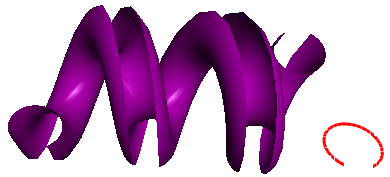Spiral surfaces.
Let's create a spiral surface with an arc-clip.
This code creates an arc:
SG_ARC ArcGeo;
SG_POINT ArP1 = {-1.0, -3.0, 0.0};
SG_POINT ArP2 = {-1.0, -2.0, 0.0};
SG_POINT ArP3 = {0.0, -3.5, 0.0};
ArcGeo.FromTreePoints(ArP1,ArP2,ArP3,false);
sgC2DObject* ar = sgCreateArc(ArcGeo);
sgGetScene()->AttachObject(ar);
ar->SetAttribute(SG_OA_COLOR,12);
ar->SetAttribute(SG_OA_LINE_THICKNESS, 2);
The axis of the spiral will lie on the (2, -3, 0) and (2, 3, 0) points. As the spiral clip isn't a closed object there will be no holes. Length of a spiral step will be 4, the spiral length - 10, and the number of meridians on the one spiral step circle will be 15:
SG_POINT axeP1 = {2.0, -3.0, 0.0};
SG_POINT axeP2 = {2.0, 3.0, 0.0};
sgC3DObject* spirO = (sgC3DObject*)sgKinematic::Spiral((const sgC2DObject&)(*ar),NULL,0,
axeP1,axeP2,4,10,15,false);
sgGetScene()->AttachObject(spirO);
spirO->SetAttribute(SG_OA_COLOR,85);
Then we'll move the obtained surface:
SG_VECTOR transV1 = {0,-11.5,0};
spirO->InitTempMatrix()->Translate(transV1);
spirO->ApplyTempMatrix();
spirO->DestroyTempMatrix();
See also:
sgGetScene sgCScene::AttachObject sgCObject::SetAttribute
Illustration:
